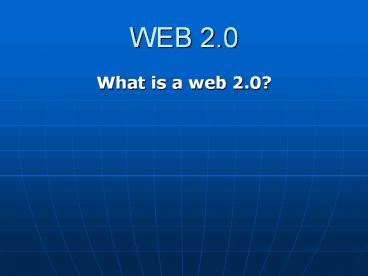Web 2.0 - PowerPoint PPT Presentation
Title: Web 2.0
1
WEB 2.0
- What is a web 2.0?
2
What is Web 2.0?
- It is Second generation of services available on
the Web that lets people collaborate and share
information online - O'Reilly Media and MediaLive International
popularized the term - Google is now seen as the torch bearer of the
term by the media - From a technology perspective Web 2.0 uses AJAX,
Mashups and RSS predominantly
3
Web 2.0 Evolution Towards a Read/Write Platform
Web 1.0(1993-2003) Pretty much HTML pages viewed through a browser Web 2.0(2003- beyond)Web pages, plus a lot of other content shared over the web, with more interactivity more like an application than a page
Read Mode Write Contribute
Page Primary Unit of content Post / record
static State dynamic
Web browser Viewed through Browsers, RSS Readers, anything
Client Server Architecture Web Services
Web Coders Content Created by Everyone
geeks Domain of mass amatuerization
4
What is Web 2.0?
- The participatory web
- The amateurization of the web
- The social web
- The user-focused web
5
What is Web 2.0?
- The Participatory Web
- . It marks the progression from static
- web pages to dynamic, interactive ones
- . Read/write web
- . Sharing, collaboration, user
- involvement
- . Reviews
- . Comment on news stories
- . Upload photos
- . Share digital videos
6
What is Web 2.0?
- The Amateurization of the Web
- . The average person can put their work
- on the web
- ex. Photographers, journalists,
- aspiring writers, students, etc.
7
What is Web 2.0?
- The Social Web
- . Social networking and community-
- oriented sites
- ex. myspace.com, facebook.com,
tagged.com, twitter,com, etc.
8
What is Web 2.0?
- The User-focused Web
- . The user needs are catered
- participate, organize, read, write play
- online
9
Why is it important? Why use Web 2.0?
- Value Content Creation
- Custom search engines
- Collaboration
- Communication
- Web-based journals/blogs
- Outreach
- Wikis
- Instruction
- Podcasts
- Training
- Videos and photos
- Resource
10
Why is it important? Why use Web 2.0?
- Participation in Knowledge Communities
- . Web 2.0 Social networks
- myspace.com, multiply.com,
- tagged.com, facebook.com, twitter.com
- friendster.com, etc.
11
Why is it important? Why use Web 2.0?
- Collaboration
- Assist people and communities to work with
distant people or community.
12
Web 2.0 Best Practices
- Create technical requirements
- Check out what others are doing
- Ask the community for help
- Prototype
- Consider different types of solutions
13
Collaboration
- With the advent of Web 2.0, we find ourselves in
an age of participation a time when all users
are empowered to contribute, regardless of
background or position.
14
Web 2.0 Tools
- Blogs a blog, or weblog, is an online journal
or web site on which articles are posted and
displayed in chronological order. - . Subject resources, book reviews, library
news, discussion groups - . Blogging software
- http//wordpress.com
- http//www.livejournal.com
- http//www.blogger.com
15
Web 2.0 Tools
- RSS and Newsreaders
- Really Simple Syndication is a technology that
enables publishers to syndicate news and other
contents on the web - Libraries are keeping up to date by subscribing
to news information sources via RSS feeds.
16
Web 2.0 Tools
- WIKIS Wiki technology provides an area for
effortless collaboration and knowledge sharing
among a community of users without any
programming knowledge. Features add a new
page, edit page, search, comments, files and
attachments, revision comparison.
17
Web 2.0 Tools
- Social Bookmarking
- . Allow users to bookmark favorite web site
articles, blog posts, podcasts, images, other
web-based materials for future retrieval. - ex. http//del.icio.us
- www.furl.net
18
Web 2.0 Tools
- Photosharing
- . Users are uploading, rating, reviewing,
annotating, searching, browsing, tagging,
creating a wealth of personal, cultural
historical digital image collections. - ex. www.flicker.com
- www.photobucket.com
- www.picazza.com
19
Web 2.0 Tools
- Social cataloging
- . Enable users to create personal catalogs
of their book, CD, DVD, game - collections, and share them with others.
- ex. www.librarything.com
20
Web 2.0 Tools
- Video Sharing
- . Enable users to share, rate, comment,
watch gather around video content free of
charge and technical expertise. - . Amateur filmmakers, karaoke hopefuls,
even talented pets have all been given a venue to
display their work. - ex. youtube.com
21
Web 2.0 Tools
- Online Chatting is the exchange of typed-in
messages requiring one site as the repository for
the messages (or "chat site") and a group of
users who take part from anywhere on the
Internet. - . Yahoo messenger
- . Google talk
- . Skype
- . Meebo
22
Web 2.0 Tools
- Online Text Messaging Provides text messaging
from internet to cell phone/mobile phone. - Ex. Chikka.com
- Yahoo messenger
23
What is AJAX?
- Ajax is not a technology in itself
- Shorthand for Asynchronous JavaScript and XML
- The term was first used by Adaptive Path only in
Feb 2005 - Removes the need to reload entire web page each
time the user makes a change. Increase the web
page's interactivity, speed, and usability. - XML is used as the format for transferring data
between the server and client. XML files may be
created dynamically by some form of server-side
scripting - The Ajax technique uses a combination of XHTML
and CSS, JavaScript, XMLHttpRequest /IFrame
object
24
Microsoft as a pioneer in Ajax
- Though hard to believe by public, in reality it
all started with IE 3.0s IFrame (and later by
Netscapes Layer) innovation to do asynchronous
loading of content - Todays AJAX core is based on Microsoft
XMLHTTPRequest Object introduced in IE 5.0 - It was used and exploited by Outlook Web Access
(OWA) in Exchange 2000 timeframe































